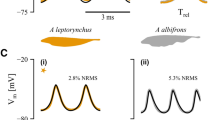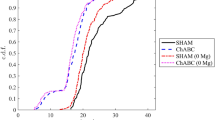Abstract
Falk and Fatt1,2 recently proposed a new equivalent circuit to account for the electrical impedance of frog sartorius and crayfish muscle fibres. In this new model (Fig. 1) the transverse impedance of the resting membrane is represented by a network of several elements rather than by a resistance and a capacitance in parallel as in the simple rc core conductor cable model3. Falk and Fatt4 have suggested that variations which have been reported in some neuromuscular junctional potentials of crustacean muscle can be attributed to the impedance properties of this more complicated circuit model. The model for frog sartorius muscle is in good agreement with other studies of the structural and electrical properties of the fibres5–8. (A model which differs somewhat from that of Falk and Fatt but is similarly complicated has been proposed for crayfish muscle9.)
This is a preview of subscription content, access via your institution
Access options
Subscribe to this journal
Receive 51 print issues and online access
$199.00 per year
only $3.90 per issue
Buy this article
- Purchase on Springer Link
- Instant access to full article PDF
Prices may be subject to local taxes which are calculated during checkout
Similar content being viewed by others
References
Falk, G., and Fatt, P., Proc. Intern. Union. Physiol. Sci., 2, XXII, Intern. Cong. abstract No. 870 (1962).
Falk, G., and Fatt, P., Proc. Roy. Soc., B, 160, 69 (1964).
Katz, B., Proc. Roy. Soc., B, 135, 506 (1948).
Falk, G., and Fatt, P., Studies in Physiology (edit. by Curtis, D. R., and McIntyre, A. K.), 64 (Springer-Verlag, Berlin, 1964).
Freygang, jun., W. H., Goldstein, D. A., Hellam, D. C., and Peachey, L. D., J. Gen. Physiol., 48, 235 (1964).
Huxley, H. E., Nature, 202, 1067 (1964).
Page, S., J. Cell Biol., 26, 377 (1965).
Adrian, R. H., and Peachey, L. D., J. Physiol., 181, 324 (1965).
Girardier, L., Reuben, J. P., Brandt, P. W., and Grundfest, H., J. Gen. Physiol., 47 (1963).
Fatt, P., and Katz, B., J. Physiol., 115, 320 (1951).
Hille, B., Nature, 210, 1220 (1966).
Steinbach, A. B., J. Gen. Physiol., 50, 1092 A (1967).
Takeuchi, A., and Takeuchi, N., J. Neurophysiol., 22, 395 (1959).
Lorente de No, R., Studies Rock. Inst., 131, 457 (1947).
Hodgkin, A. L., and Rushton, W. A. H., Proc. Roy. Soc., B, 133, 444 (1946).
Maeno, T., J. Physiol., 183, 592 (1966).
Steinbach, A. B., Abstracts Biophysical Soc., eleventh annual meeting, 114 (1967).
Author information
Authors and Affiliations
Rights and permissions
About this article
Cite this article
STEINBACH, A. Unusual Endplate Potentials which reflect the Complexity of Muscle Structure. Nature 216, 1331–1333 (1967). https://doi.org/10.1038/2161331a0
Received:
Revised:
Issue Date:
DOI: https://doi.org/10.1038/2161331a0
This article is cited by
-
Equilibrium potentials of postsynaptic membrane activated by various cholinomimetics during changes in extracellular ionic medium
Neuroscience Translations (1969)
Comments
By submitting a comment you agree to abide by our Terms and Community Guidelines. If you find something abusive or that does not comply with our terms or guidelines please flag it as inappropriate.



